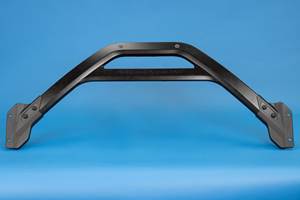SAMPE Paris event highlights composites for auto, infrastructure
Summit Paris 2016, held one day before JEC World 2016, focused on emerging and creative technologies for cars and for bridges.
SAMPE Europe held its one-day Summit Paris 2016 event at the Pullman Hotel with a close-up view of the Tour Eiffel. The event was structured with four blocks of papers focused on Automotive, Advanced Products & Engineering, Composites in Architecture and Infrastructure, and Aerospace.
Among the 13 papers was an informative presentation by Heinrich Timm, formerly a director of Audi’s Lightweight Center and currently a board member of Carbon Composites e.V. (an association of companies and research institutes that covers the composites value chain in Germany, Austria and Switzerland, founded in 2007). Timm related that his group at Audi studied the impact of mass, and how high-strength steels, aluminum and composites all played a part in creating sufficient stiffness for the automaker’s car bodies. He described how aluminum castings designed in specific shapes were employed in the A8 model in a space frame concept that provided design freedom to cut mass, when employed in concert with steel for stiffness. He emphasized that trial and error will not guide designers to the best solution, that carbon is not a replacement for metal, and that virtual simulation is a must for a multi-material concept, to take advantage of carbon fiber’s anisotropy. He described a Carbon Composites e.V. project that aims to reduce the processing cost of carbon composites by 90%, and material cost by 50%: “If we don’t reach these numbers, carbon fiber won’t be going into mainstream automotive.” Nevertheless, he cited the Audi 7-Series’ “patchwork” hybrid approach with carbon in selected areas, and the benefits of system integration. He added, “Don’t accept your accountant’s worries about material cost!” and concluded with the prediction that about 15% of a car body in carbon composite would make sense.
Roeland Coumans of CeraCarbon (Stein, The Netherlands) described a new material, called CeraCarbon, consisting of carbon fiber laminate tubes coated with a ceramic material. Since a patent is pending, specific details were few, but Coumans related that his product has already been adopted by Moto GP motorcycle racing teams for suspension elements that typically see wear and abrasion. CeraCarbon suspension elements are 75% lighter, saving 1.5 kg in unsprung weight — a huge advantage. He related that aircraft landing gear elements and helicopter blades would be promising applications.
Jan Peeters of FiberCore Europe (Rotterdam, The Netherlands) impressed the audience with no-nonsense descriptions of his company’s cost-effective and durable way to build robust composite bridges. Using a reconfigurable mold, automated methods and serial production, FiberCore has installed more than 450 structures so far in Europe, and at costs that are often less than traditional materials. His Infracore concept of stacked, Z-style composite beams eliminates the Achilles Heel of composites in bridges: interlaminar shear and subsequent delamination. He described an upcoming project involving a 100m free span in composites, which will require 50 tonnes of resin for the infusion, in one shot. FiberCore grew by 50% in 2015, thanks to its “completely new way of thinking,” says Peeters.
Valentin Koslowski of the University of Stuttgart (Stuttgart, Germany) gave a fascinating paper on a bio-based architectural concept: replicating spider cocoons with carbon and glass fiber to form novel architectural spaces. The process starts with an inflated polymer bag, with shape maintained with positive pressure. An articulated robot inside the bag places individual tows of carbon or glass against the plastic; the end effector developed by the university is able to stick the tow to the plastic without applying so much pressure that the bag breaks. The composite tows cure at ambient temperature to form arching, random fiber strands that are programmed based on the natural spider cocoon elements. When cured, the bag is removed, and the resulting graceful and interesting “room” or space is left. The group has also advanced other innovative methods of robotic placement to form “trees” or biotic elements; one of their designs will be installed this year at the Albert and Victoria Museum in London as a sun canopy.
Related Content
Automotive chassis components lighten up with composites
Composite and hybrid components reduce mass, increase functionality on electric and conventional passenger vehicles.
Read MoreTPI manufactures all-composite Kenworth SuperTruck 2 cab
Class 8 diesel truck, now with a 20% lighter cab, achieves 136% freight efficiency improvement.
Read MoreJeep all-composite roof receivers achieve steel performance at low mass
Ultrashort carbon fiber/PPA replaces steel on rooftop brackets to hold Jeep soft tops, hardtops.
Read MoreInfinite Composites: Type V tanks for space, hydrogen, automotive and more
After a decade of proving its linerless, weight-saving composite tanks with NASA and more than 30 aerospace companies, this CryoSphere pioneer is scaling for growth in commercial space and sustainable transportation on Earth.
Read MoreRead Next
The next-generation single-aisle: Implications for the composites industry
While the world continues to wait for new single-aisle program announcements from Airbus and Boeing, it’s clear composites will play a role in their fabrication. But in what ways, and what capacity?
Read More“Structured air” TPS safeguards composite structures
Powered by an 85% air/15% pure polyimide aerogel, Blueshift’s novel material system protects structures during transient thermal events from -200°C to beyond 2400°C for rockets, battery boxes and more.
Read MoreCombining multifunctional thermoplastic composites, additive manufacturing for next-gen airframe structures
The DOMMINIO project combines AFP with 3D printed gyroid cores, embedded SHM sensors and smart materials for induction-driven disassembly of parts at end of life.
Read More











.jpg;maxWidth=300;quality=90)














